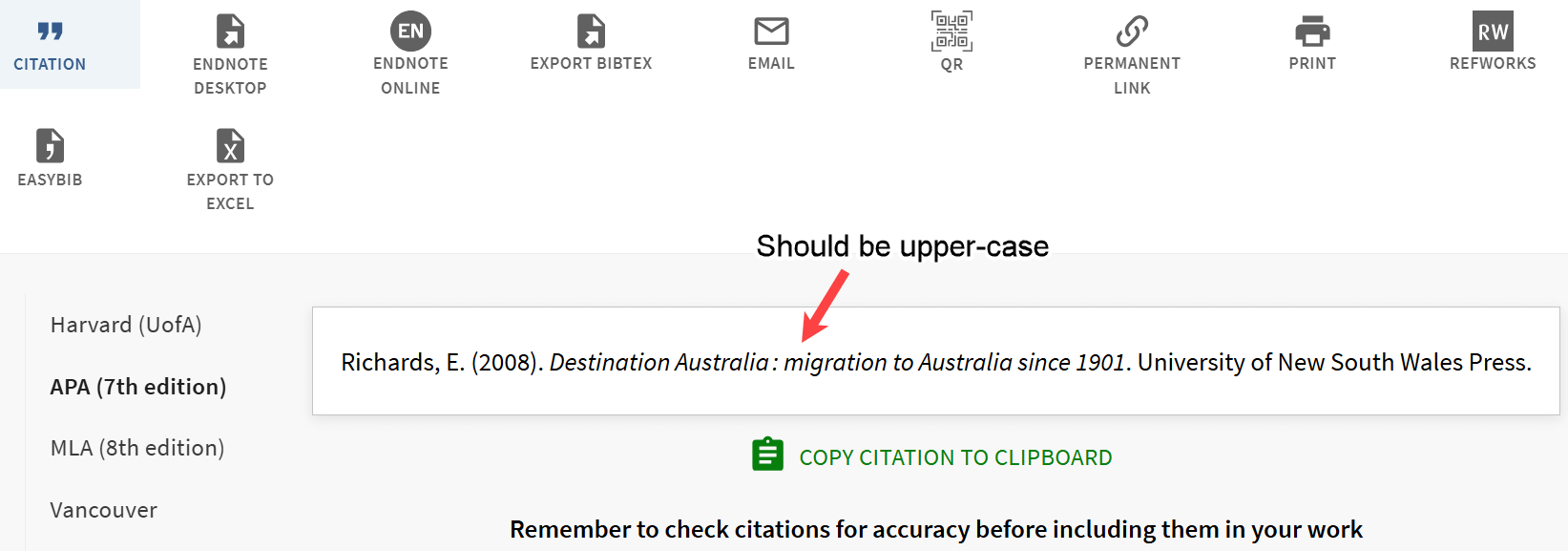- Home
- Citations
How to Cite Sources in APA Format
Include in-text citations and a reference list to cite sources in APA format.
In-text citations appear within your writing and point to the full source in the reference list, for example:
- Narrative: As Smith (2020) explains, clear citation helps readers trace your sources.
- Parenthetical: Clear citation helps readers trace your sources (White, 2018).
Reference list entries appear at the end of your document and contain the author, date, title, and source, for example:
White, R. (2018). Academic writing made simple. University Press.
Ways to Cite Sources in APA Format
There are three main ways to cite sources in APA format:
-
Create the citation yourself.
Enter the in-text citations and reference list entries yourself following APA guidelines.
Advantage: You learn APA citation structure and rules by manually citing the sources.
Disadvantage: It is time-consuming, especially if you have many sources to cite. - Use a Citation Generator.
Input or import your source details into a citation generator, which automatically inserts APA-formatted in-text citations and reference list entries into your document.
Advantage: Citations are created quickly, and APA formatting is automatically applied.
Disadvantage: Citation generators may make errors that you will need to correct. -
Use provided citation information.
Copy the citation details provided, for example, in a journal article or book.
Advantage: It’s quick — you can copy and paste the citation into your work.
Disadvantage: You must check the format carefully. It may not follow APA rules exactly.
I recommend to try creating the citation yourself first to learn the correct APA format — then use generators or provided citations more confidently.
Create the Citation Yourself
Building a citation yourself helps you learn APA formatting rules such as punctuation, italics, and the order of information (author, date, title, and source).
This will help you:
-
Spot and fix mistakes when using a citation generator, AI tool, or copied details from a source (such as a journal).
- Develop a sharper eye for detail and stronger editing skills.
- Produce better academic work.
Choose the type of source you want to cite in APA format:
Use a Citation Generator
Citation generators can make it much easier to cite sources in APA format by creating both in-text citations and reference list entries automatically.
During your course, you may collect many references. Some will be used in one assignment, and others may be useful again in future work.
Zotero is a popular free citation generator that supports APA 7th Edition formatting. It also works with other citation styles if needed.
To use it, you enter the details of your source — often just an identifier such as an ISBN for books or a DOI for articles.
The citations are stored in your Zotero library. In your Word document, you can then insert in-text citations and automatically create a reference list in APA format.
See how to use Zotero for more information.
Use provided citation information
Some sources include a ready-made citation for you to use.
For example, a journal article may show a “How to cite this paper” note, or a book might list a suggested citation in its opening pages.
However, a provided citation is not guaranteed to be correct. Even when it looks accurate, there may be small differences from APA rules, such as punctuation changes, missing italics, or a missing DOI.
Always check each one carefully before using it.
When you use a provided citation, add it to your reference list first. Then check each part against APA rules, for example :
- Formatting of author names and initials
- Format of the date
- Capitalization of book and article titles (sentence case) and journal titles (title case)
- Use of italics and punctuation
- Inclusion of DOIs or URLs when required
Figures 1 and 2 are examples of copied citations that are incorrect.
 Figure 1: Copied Citation with Subheading Not Capitalized
Figure 1: Copied Citation with Subheading Not Capitalized Figure 2: Incorrect Citation with Title Case Heading and Unneeded Edition
Figure 2: Incorrect Citation with Title Case Heading and Unneeded EditionFigure 3 is an example of a correctly APA formatted citation that has been copied.
 Figure 3: Correct Copied Citation With Main Heading Only
Figure 3: Correct Copied Citation With Main Heading OnlyNote: Provided citations usually give only the reference list entry. You will still need to create and insert the in-text citations yourself.
Summary
To cite sources in APA format:
- Use in-text citations (narrative or parenthetical) to refer to your sources within your writing.
- Include a reference list at the end with full details of every source you cite.
- Follow APA formatting rules for author names, dates, titles, and source details.
- You can create citations manually, use a citation generator, or copy the provided citation.
- Start with manual entry to learn the rules, then use a citation generator (such as Zotero) to create citations in APA 7th edition format.
Frequently Asked Questions
What is the difference bewteen "APA Style" and "APA Format"?
What is the difference bewteen "APA Style" and "APA Format"?
APA style refers to the overall guidelines set by the American Psychological Association (APA), covering writing style, tone, bias-free language, clarity, punctuation, citation, and more.
APA format refers specifically to the structural and formatting rules for your document—like margins, font, spacing, heading levels, and reference layout.
Why is it important to cite sources in academic writing?
Why is it important to cite sources in academic writing?
Citing your sources:
What is the difference between a reference list and a bibliography?
What is the difference between a reference list and a bibliography?
A reference list includes only the works you cited in your writing.
A bibliography includes all works you consulted, whether or not you cited them.
APA style requires only a reference list. Only works cited in your work should be provided.